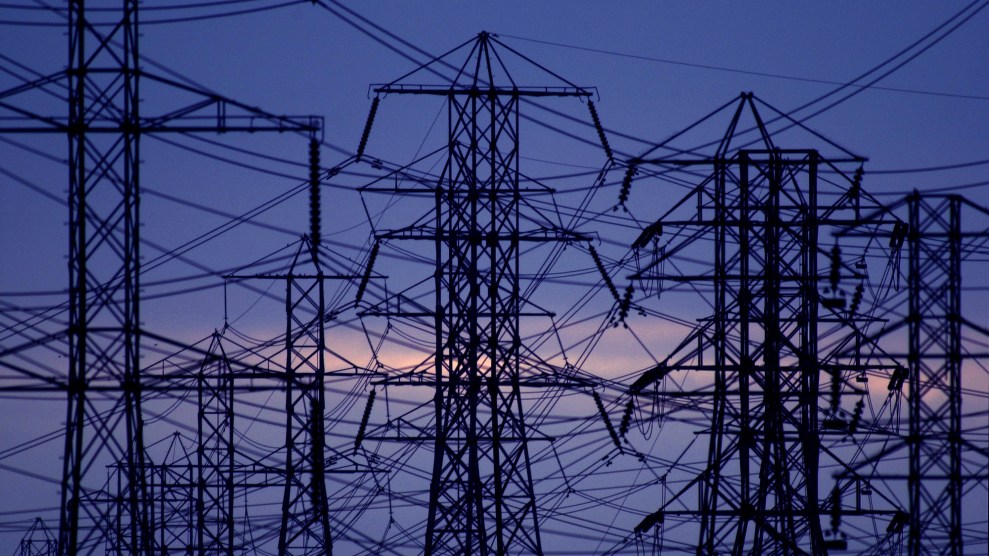
David McNew/Getty
The California state Senate held a marathon out-of-session hearing Monday in response to the ongoing statewide blackouts that have thrown Californians into chaos over the past couple months, giving the public a startling snapshot of what happened.
Starting last month, state utility companies—PG&E chief among them—launched a (sometimes poorly) executed series of blackouts in an effort to avoid starting fires during unusually high wind events. Ahead of another planned PG&E outage in swaths of Northern California starting Wednesday, legislators wanted answers from the state’s three major investor-owned utility companies—PG&E, San Diego Gas & Electric, and Southern California Edison—about how they plan to better manage future power shutdowns, with PG&E taking most of the heat.
The hearing painted an apocalyptic picture of millions of people and emergency response teams left in the dark, shockingly without any form of communication, as wildfires sparked anyway and cell service went down at an unexpected scale. Talking about the Kincade fire that raged through Sonoma in late October, Christopher Godley, director of the Sonoma County Department of Emergency management, said: “I literally drove up to the fire that night two hours into it, and I stared at that fire coming down the hill knowing that I could not warn my community, that my community could not receive my phone calls, my cable messages. I could not reach them.”
Lawmakers on Monday also invited regulators, representatives from relevant government agencies, and members of impacted communities to talk about their views of and experiences in the recent blackouts. The arduous eight-hour hearing was filled with stories of loss and hardship, during which the different stakeholders took turns calling out failures and demanding (and at times proposing) solutions. In the end, the proceedings highlighted how disruptive and even devastating the outages have been and how many improvements must be made—and made quickly. “We thought that PG&E would use a scalpel in implementing these planned blackouts, and instead PG&E has chosen to use a sledgehammer,” state Sen. Scott Wiener said.
90 state agencies mobilized to respond to the outages, and local governments, schools, hospitals, and shelters had to divert funds to emergency services to deal simultaneously with fires and the the unintended consequences of the blackouts—locating and warning elderly and rural residents without power and information in evacuation zones, coordinating with utilities to open more emergency centers, and finding generators for everything from 911 call centers to hospitals to schools. As usual, low-income and medically vulnerable communities bore the brunt of the crisis.
While it’s still too early to know the full scale of October’s power outages, what we do now know is unsettling—and unfortunately, it offers something of a preview for the blackouts PG&E expects Californians to likely deal with for the better part of a decade.
Here are a few numbers that stand out:
Landline, cell, and wireless service
- 86,000 customers of wireline services (wireless, cell, wifi) lost connection.
- 1,600 cell towers shut down.
- 57 percent of Marin County, with a population of over 260,000, lost cell service.
- The entirety of Mendocino County, with almost 90,000 people, lost all data capabilities, landline, and cell service.
- During the outage from October 9 to 11, while fires raged, Contra Costa County had 88 cell towers down, which Aaron McAlister, the deputy fire chief of the county’s Fire Protection District, called “one of the most critical” problems they faced. “We couldn’t deliver evacuation warnings to residents in our community because those cell towers were down.”
Vulnerable communities
- There were thousands of public health facilities serving tens of thousands of residents in the outage zones.
- California Health and Human Services Secretary Mark Ghaly estimated there were “many hundreds of thousands of potentially impacted people who receive services through state agencies.” This could mean everything from those reliant on state-funded health care to welfare and other social services.
- There were up to 250,000 affected people in the In-home Supportive Services Program, which helps pay for support like house cleaning, grocery shopping, paramedical care, and supervision for the elderly or disabled.
- Already resource-strapped food banks struggled to deal with the influx of need during the blackouts, especially since “there was ineffective communication from PG&E in press releases on the role of the food banks in their territory,” according to Andrew Cheyne, director of government affairs for the California Association of Food Banks. One program in Shasta saw an unsustainable 23 percent increase in service. Humboldt County suffered the greatest food loss, as the the whole county was de-energized.
Economic impact
- Sonoma County suffered $50 to $70 million in total economic losses in the blackout lasting October 8 to 11 alone, according to an analysis by the County Economic Development Board and Moody’s.
- Before the most recent shutdown even occurred in late October, Sonoma County—still struggling from the costs of last year’s fires—had already spent $4.5 million from its general fund to deal with the outages.
- To close schools during last month’s blackouts in the Oroville Unified High School District in Butte County (the site of the 2018 Camp Fire), Superintendent Corey Willenburg says it would cost him $107,000 each day. So instead of closing his doors, he spent $20,000 on generators, fuel, and extra help out of his general fund which cannot be replaced to support the student body, 77 percent of whom are socioeconomically disadvantaged.

















